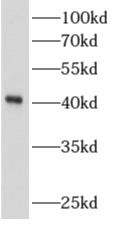Products
ALKBH1 antibody
| Synonyms: | Nucleic acid dioxygenase ALKBH1|Alkylated DNA repair protein alkB homolog 1|Alpha-ketoglutarate-dependent dioxygenase ABH1|DNA 6mA demethylase|DNA N6-methyl adenine demethylase ALKBH1|DNA lyase ABH1|DNA oxidative demethylase ALKBH1|mRNA N(3)-methylcytidine demethylase|ALKBH1|ABH|ABH1|ALKBH antibody | ||
| Catalogue No.: | FNab00311 | Reactivity: | Human, Mouse, Rat |
| Host: | Rabbit | Tested Application: | ELISA, WB, IHC |
| Clonality: | polyclonal | Isotype: | IgG |
| Size | Price |
|---|---|
| 100µg | Inquiry |
- SPECIFICATIONS
- FIGURES
- CONDITIONS
- FAQS
- Product Name
- ALKBH1 antibody
- Catalogue No.
- FNab00311
- Size
- 100μg
- Form
- liquid
- Purification
- Immunogen affinity purified
- Purity
- ≥95% as determined by SDS-PAGE
- Clonality
- polyclonal
- Isotype
- IgG
- Storage
- PBS with 0.02% sodium azide and 50% glycerol pH 7.3, -20℃ for 12 months(Avoid repeated freeze / thaw cycles.)
- Immunogen
- alkB, alkylation repair homolog 1(E. coli)
- Alternative Names
- Nucleic acid dioxygenase ALKBH1|Alkylated DNA repair protein alkB homolog 1|Alpha-ketoglutarate-dependent dioxygenase ABH1|DNA 6mA demethylase|DNA N6-methyl adenine demethylase ALKBH1|DNA lyase ABH1|DNA oxidative demethylase ALKBH1|mRNA N(3)-methylcytidine demethylase|ALKBH1|ABH|ABH1|ALKBH antibody
- UniProt ID
- Q13686
- Observed MW
- 44 kDa
- Tested Applications
- ELISA, WB, IHC
- Recommended dilution
- WB: 1:200-1:2000; IHC: 1:20-1:200
 human placenta tissue were subjected to SDS PAGE followed by western blot with FNab00311(ALKBH1 antibody) at dilution of 1:500
human placenta tissue were subjected to SDS PAGE followed by western blot with FNab00311(ALKBH1 antibody) at dilution of 1:500
 Immunohistochemistry of paraffin-embedded human colon tissue slide using FNab00311(ALKBH1 Antibody) at dilution of 1:50
Immunohistochemistry of paraffin-embedded human colon tissue slide using FNab00311(ALKBH1 Antibody) at dilution of 1:50
- Background
- Dioxygenase that acts as a DNA demethylase(PubMed:18603530). Requires molecular oxygen, alpha-ketoglutarate and iron(PubMed:18603530). Specifically demethylates DNA methylated on the 6th position of adenine(N(6)-methyladenosine) DNA. N(6)-methyladenosine(m6A) DNA is present at some L1 elements in embryonic stem cells and probably promotes their silencing(By similarity). Also able to repair alkylated single-stranded DNA and RNA containing 3-methylcytosine by oxidative demethylation, but with low activity(PubMed:18603530). Also has DNA lyase activity and introduces double-stranded breaks at abasic sites: cleaves both single-stranded DNA and double-stranded DNA at abasic sites, with the greatest activity towards double-stranded DNA with two abasic sites(PubMed:19959401). DNA lyase activity does not require alpha-ketoglutarate and iron and leads to the formation of an irreversible covalent protein-DNA adduct with the 5' DNA product(PubMed:19959401, PubMed:23577621). DNA lyase activity is not required during base excision repair and class switch recombination of the immunoglobulin heavy chain during B lymphocyte activation. May play a role in placental trophoblast lineage differentiation(By similarity).
How many times can antibodies be recycled?
First, usually it's not suggested to recycle antibodies. After use, buffer system of antibodies has changed. The storage condition of recycled antibodies for different customers also varies. Thus, the performance efficiency of recycled antibodies can’t be guaranteed. Besides, FineTest ever conducted the antibody recycling assay. Assay results show recycling times of different antibodies also varies. Usually, higher antibody titer allows more repeated use. Customers can determine based on experimental requirements.
Notes: After incubation, we recycle rest antibodies to centrifuge tube and store at 4℃. High titer antibodies can be stored for a minimum of one week. Reuse about three times.
What are components of FineTest antibody buffer?
Components of FineTest antibody buffer are usually PBS with proclin300 or sodium azide, BSA, 50% glycerol. Common preservative is proclin300 or sodium azide, which is widely applied in the lab and industry.
How about the storage temperature and duration of FineTest antibodies?
Most antibodies are stored at -20℃. Directly-labeled flow cytometry antibodies should be stored at 2 - 8℃. The shelf life is one year. If after sales issues for purchased antibodies appear, return or replacement is available. Usually, antibodies can be still used after the one-year warranty. We can offer technical support services.
Is dilution required for FineTest antibodies? What’s the dilute solution?
Directly-labeled flow cytometry antibodies are ready-to-use without dilution. Other antibodies are usually concentrated. Follow the dilution ratio suggested in the manual. Dilute solution for different experiments also varies. Common antibody dilution buffers are acceptable(e.g. PBST, TBST, antibody blocking buffer).
How to retrieve antibodies for immunohistochemistry?
Common retrieval buffers: Tris-EDTA Buffer(pH 9.0); Citrate Buffer(pH 6.0)
Heat induced antibody retrieval:
Method 1: Water-bath heating: Put the beaker with retrieval buffer and slide in the boiling water bath. Keep the boiling state for 15min. Naturally cool to room temperature;
Method 2: Microwave retrieval: Put the beaker with retrieval buffer and slide in the microwave oven. Heat at high power for 5min, Switch OFF for 3min, Heat at medium power for 5min. Naturally cool to room temperature.
How to choose secondary antibodies?
(1) Secondary antibodies react with primary antibodies. Thus, secondary antibodies should be against host species of primary antibodies. E.g. If the primary antibody is derived from rabbit, the relevant secondary antibody should be against rabbit. E.g. goat anti rabbit or donkey anti rabbit.
(2) Choose secondary antibody conjugates according to the experimental type, e.g. ELISA, WB, IHC etc. Common enzyme conjugated secondary antibodies are labelled by HRP, AP etc. Fluorescin or dye labelled secondary antibodies are applied in immunofluorescence and flow cytometry(e.g. FITC, Cy3).
